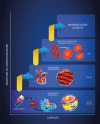Chemotherapy-induced Cardiac18F-FDG Uptake in Patients with Lymphoma: An Early Metabolic Index of Cardiotoxicity?
- PMID: 35703659
- PMCID: PMC9345149
- DOI: 10.36660/abc.20210463
Chemotherapy-induced Cardiac18F-FDG Uptake in Patients with Lymphoma: An Early Metabolic Index of Cardiotoxicity?
Abstract
Background: It is uncertain whether myocardial fluorodeoxyglucose uptake occurs solely due to physiological features or if it represents a metabolic disarrangement under chemotherapy.
Objective: To investigate the chemotherapy effects on the heart of patients with lymphoma by positron emission tomography associated with computed tomography scans (PET/CT) with 2-deoxy-2[18F] fluoro-D-glucose (18F-FDG PET/CT) before, during and/or after chemotherapy.
Methods: Seventy patients with lymphoma submitted to18F-FDG PET/CT were retrospectively analyzed. The level of significance was 5%.18F-FDG cardiac uptake was assessed by three measurements: left ventricular maximum standardized uptake value (SUVmax), heart to blood pool (aorta) ratio, and heart to liver ratio in all the exams. Body weight, fasting blood sugar, post-injection time, and the injected dose of18F-FDG between the scans were also compared.
Results: Mean age was 50.4 ± 20.1 years and 50% was female. The analysis was carried out in two groups: baseline vs. interim PET/CT, and baseline vs. post-therapy PET/CT. There was no significant difference in clinical variables or protocol scans variables. We observed an increase in left ventricular (LV) SUVmax from 3.5±1.9 (baseline) to 5.6±4.0 (interim), p=0.01, and from 4.0±2.2 (baseline) to 6.1±4.2 (post-therapy), p<0.001. A percentage increase ≥30% of LV SUVmax occurred in more than half of the sample. The rise of cardiac SUV was accompanied by an increase in LV SUVmax/Aorta SUVmax and LV SUVmean/Liver SUVmean ratios.
Conclusion: This study showed a clear increase in cardiac18F-FDG uptake in patients with lymphoma during and/or after chemotherapy. The literature corroborates with these findings and suggests that18F-FDG PET/CT is a sensitive and reliable imaging exam to detect early metabolic signs of cardiotoxicity.
Fundamento: Ainda não está estabelecido se a captação de fluorodesoxiglicose no miocárdio ocorre exclusivamente por características fisiológicas ou se representa um desarranjo metabólico causado pela quimioterapia.
Objetivo: Investigar os efeitos da quimioterapia no coração dos pacientes com linfoma por tomografia por emissão de pósitrons associada a tomografia computadorizada (PET/CT) com 2-[18F]-fluoro-2-desoxi-D-glicose (18F-FDG PET/CT) antes, durante e/ou após a quimioterapia.
Métodos: Setenta pacientes com linfoma submetidos a 18F-FDG PET/CT foram retrospectivamente analisados. O nível de significância foi de 5%. A captação de 18F-FDG foi avaliada por três medidas: captação máxima no ventrículo esquerdo ( standardized uptake value , SUV max), razão SUV cardíaco / aorta e SUV cardíaco / SUV no fígado. Também foram comparados peso corporal, glicemia de jejum, tempo pós-injeção e dose administrada de 18F-FDG entre os exames.
Resultados: A idade média foi de 50,4 ± 20,1 anos e 50% dos pacientes eram mulheres. A análise foi realizada em dois grupos – PET/CT basal vs. intermediário e PET/CT basal vs pós-terapia. Não houve diferença significativa entre as variáveis clínicas e do protocolo dos exames entre os diferentes momentos avaliados. Nós observamos um aumento na SUV máxima no ventrículo esquerdo de 3,5±1,9 (basal) para 5,6±4,0 (intermediário), p=0,01, e de 4,0±2,2 (basal) para 6,1±4,2 (pós-terapia), p<0,001. Uma porcentagem de aumento ≥30% na SUV máxima no ventrículo esquerdo ocorreu em mais da metade da amostra. O aumento da SUV cardíaca foi acompanhado por um aumento na razão SUV máxima no ventrículo esquerdo / SUV máxima na aorta e SUV média no ventrículo esquerdo /SUV média no fígado.
Conclusão: O estudo mostrou um aumento evidente na captação cardíaca de 18F-FDG em pacientes com linfoma, durante e após quimioterapia. A literatura corrobora com esses achados e sugere que a 18F-FDG PET/CT pode ser um exame de imagem sensível e confiável para detectar sinais metabólicos precoces de cardiotoxicidade.
Conflict of interest statement
Potencial conflito de interesse
Não há conflito com o presente artigo
Figures








Comment in
-
Precision Medicine: Can 18F-FDG PET Detect Cardiotoxicity Phenotypes?Arq Bras Cardiol. 2022 Jul;119(1):109-110. doi: 10.36660/abc.20220393. Arq Bras Cardiol. 2022. PMID: 35830108 Free PMC article. English, Portuguese. No abstract available.
References
-
- Kalil Filho R, Hajjar LA, Bacal F, Hoff PM, Diz MP, Galas FR, et al. I Brazilian Guideline for Cardio-Oncology from Sociedade Brasileira de Cardiologia. Arq Bras Cardiol. 2011;96(2 Suppl 1):1-52. - PubMed
-
- Jain D, Russell RR, Schwartz RG, Panjrath GS, Aronow W. Cardiac Complications of Cancer Therapy: Pathophysiology, Identification, Prevention, Treatment, and Future Directions. Curr Cardiol Rep. 2017;19(5):36. doi: 10.1007/s11886-017-0846-x. - PubMed
-
- Seidman A, Hudis C, Pierri MK, Shak S, Paton V, Ashby M, et al. Cardiac Dysfunction in the Trastuzumab Clinical Trials Experience. J Clin Oncol. 2002;20(5):1215-21. doi: 10.1200/JCO.2002.20.5.1215. - PubMed
-
- Curigliano G, Cardinale D, Suter T, Plataniotis G, Azambuja E, Sandri MT, et al. Cardiovascular Toxicity Induced by Chemotherapy, Targeted Agents and Radiotherapy: ESMO Clinical Practice Guidelines. Ann Oncol. 2012;23(Suppl 7):155-66. doi: 10.1093/annonc/mds293. - PubMed
MeSH terms
Substances
LinkOut - more resources
Full Text Sources
Medical

